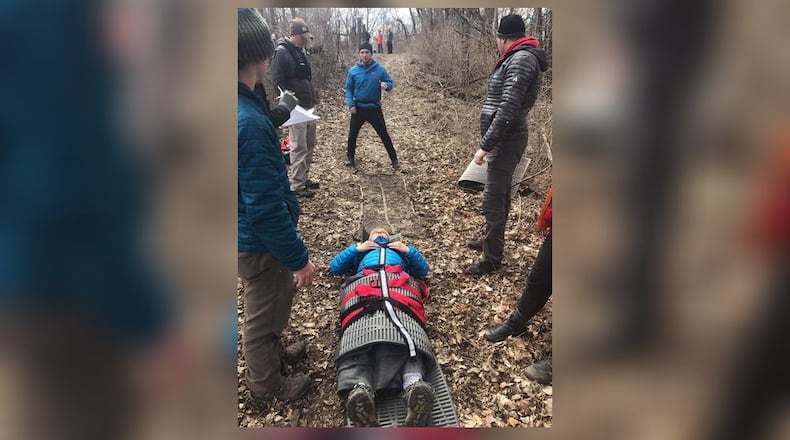Those are just a few of the many situations addressed in wilderness first aid classes. Niekamp is hosting a two-day Wilderness First Aid (WFA) course September 24-25 at Lost Creek Reserve in Troy.
Wilderness first aid training focuses on treating injuries and illnesses in remote environments – areas where you are one-to-two hours away from advanced care. Those areas might be closer than you think.
“Remote environments aren’t always wilderness or backcountry areas,” Niekamp said. “You can be in parts of Caesar Creek State Park or local parks where you would be more than an hour from advanced care if an injury occurs.”
Wilderness first aid training is designed to give outdoor enthusiasts the skills and confidence to handle a variety of injuries.
“If someone breaks an arm at home you would call 911 or drive them to a hospital,” Niekamp said. “In a backcountry situation, you might apply a splint, immobilize the arm and monitor circulation, sensation, and movement of their fingers before getting them to advanced care.”
Accidents happen
Niekamp – with more than 30,000 miles of hiking under his belt – has administered backcountry first aid many times.
“The serious situations I encountered included choking on food, a cardiac issue, broken bones, a lightning strike, a bicycle accident, and a head wound from falling,” he said. “Four of these situations required a call to 911 and an evacuation. In addition, many times I’ve been called upon to help with less urgent issues such as sprains, scrapes, scratches, ticks, heat exhaustion, blisters, and mild hypothermia. I’ve learned that accidents don’t come with a notice.”
According to HikersDaily – with data from National Park Service studies – there are an estimated 4,000-5,000 injuries related to hiking annually in the United States with falls or slips accounting for approximately half of them.
The ankle is the most-commonly injured body part while hiking, accounting for 42 percent of hiking injuries, followed by the head at 13.4 percent.
Planning and preparation are key
Be prepared is more than the Boy Scouts’ motto, it’s a necessity when hiking or backpacking.
“Dangers can happen when you least expect it,” said Rob Pinchot, a local leader for both the Boy and Girl Scouts. “And the further away you are from the car or cell service, the more dangerous it gets.”
Planning and preparation are key to a safe and fun backcountry experience.
“The more you know, the better off you’ll be,” Pinchot said.
From checking the weather and wearing the right footwear to having a map and carrying a first aid kit, a little preparation will go a long way. For scouts, that preparation includes a variety of first aid training – something Pinchot recommends for everyone.
“It’s important to have that knowledge,” he said.
SOLO Wilderness First Aid
What: A two-day, 16-hour course focusing on real-life, entry-level skills of patient assessment, bone and joint injuries, wounds/infection, shock, spinal injuries, soft tissue injuries, environmental emergencies, and medical emergencies including allergies and anaphylaxis. Part of the course is taught indoors classroom-style and other parts are taught outdoors with mock scenarios and hands-on training.
When: September 24-25
Where: Lost Creek Reserve, Troy
Info: www.outdooradventureconnection.com
What’s in Andy’s first aid kit?
First aid kits should be tailored to your activity. A backpacker will carry different items than a kayaker, mountain biker, or horseback rider. In my hiking and backpacking first aid kit I always include these items:
· Band-Aids
· gauze
· sterile pads
· antiseptic wipes
· antibacterial ointment
· medical adhesive tape
· ACE bandage
· SAM splint
· elastic knee brace
· triangle bandage
· glucose tablets
· aspirin
· EpiPen
· scissors
· tweezers
· nitrile gloves
· CPR mask
· space blanket
· pen and paper
About the Author



